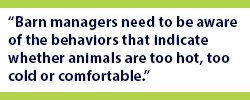
Managing Air Quality From a Swine Perspective
 By Dave Chamberlin, Vita Plus swine technical sales manager, and Garrett Rozeboom, Vita Plus swine technical services manager
By Dave Chamberlin, Vita Plus swine technical sales manager, and Garrett Rozeboom, Vita Plus swine technical services managerAlthough we focus on animals with only one stomach, many of the practices we use to manage pigs translate across species. We must constantly improve the efficiency of how we manage our barns without sacrificing animal performance and health. This is especially true when it comes to barn ventilation. These are our top five rules for managing ventilation in swine barns:
1. Air is an essential nutrient
 Animals need fresh air to digest, absorb and convert nutrients into energy. The more fresh air an animal gets, the more it eats and the faster it grows. In the swine industry, we are constantly watching how many cubic feet of air move through the barn per minute (CFMs) and how well the air is mixed throughout the barn. We then set up our fan stages to move the desired CFMs through the barn to meet pigs’ needs specific to their stage of growth.
Animals need fresh air to digest, absorb and convert nutrients into energy. The more fresh air an animal gets, the more it eats and the faster it grows. In the swine industry, we are constantly watching how many cubic feet of air move through the barn per minute (CFMs) and how well the air is mixed throughout the barn. We then set up our fan stages to move the desired CFMs through the barn to meet pigs’ needs specific to their stage of growth.
The number one issue we see in hog barns is pigs not getting enough air because the manager is worried about temperature, which brings us to our next ventilation rule.
2. Temperature is just a number
People love numbers because they are black and white, easy to follow, and remove opinion. However, the animals in the barn don’t know a temperature; they know how they feel. Barn managers need to be aware of the behaviors that indicate whether animals are too hot, too cold or comfortable.
 If the animal is too cold, don’t forget rule number one. Turning off all the fans is likely NOT the best solution. Utilize your controllers to adjust fan timing and rotation to keep air moving. If we don’t bring fresh air into the barn while pulling out humid stale air, we fail to provide good air quality to our animals.
If the animal is too cold, don’t forget rule number one. Turning off all the fans is likely NOT the best solution. Utilize your controllers to adjust fan timing and rotation to keep air moving. If we don’t bring fresh air into the barn while pulling out humid stale air, we fail to provide good air quality to our animals.
3. Heat rises
This may seem simple, but it haunts barn managers in two ways:
- First, thermometers and controller probes are often mounted closer to the ceiling than the animal. Managing the air above or below the space where the animal resides does not help you manage the animal. You need to monitor the plane in which the animals live. Utilize thermometers and temperature probes at animal height.
- Secondly, we see barns not working with this concept to heat and/or cool the barn. If it’s winter and you’re trying to keep the animal warm, utilize fans and inlets to push or pull the heat rising off the animal back to the animal. Do not blast the fans; this will force the warm air to hit the ceiling, condense and rain in the barn. If it is summer, utilize ridge vents to allow hot air to escape and not hover over the animals.
4. High humidity equals low health
Humidity is not your friend. It creates the perfect breeding ground for respiratory diseases. There are only two cures for it: move more air or add supplemental heat. We like the first option because it costs less and has a greater positive impact on air quality. Assuming most calf barns do not have heaters, your best bet is to move more air at animal height or lower.
5. You are not a pig (or calf)
It’s funny, as farmers, we don’t want our consumers to anthropomorphize our livestock by assuming animals have the same emotions as humans. But then we try to make our barns comfortable for people. Your goal should be to read the animal and do what helps them thrive, not what feels most comfortable to you.
| Category: |
Animal health Equipment Starting Strong - Calf Care |

